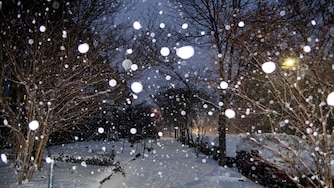A long-awaited neighborhood revitalization plan encompassing a triangle-shaped parcel in Northeast Baltimore aims to create a “next-generation prototype” for sustainable community development, a team of developers, architects and engineers said Thursday.
Presenting to a Baltimore architecture and design review panel, the cohort behind the planned Tivoly Eco-Village laid out a comprehensive vision for the about 8-acre site, which it said would feature a mix of housing types situated around a community clubhouse and park and connected by pedestrian-only laneways.
Each net-zero energy home would make use of solar panels and would be connected to a microgrid that the neighborhood homeowners’ association would manage, said Mark James, founder and president of Urban Green, LLC, one of the project’s lead developers. The team said it also planned for the neighborhood to incorporate organic farming, rainwater harvesting and stormwater management.
James said the plan, which would yield dozens of for-sale homes in a long-neglected stretch of Baltimore, centers on environmental and social sustainability. The development team won a bid to redevelop the so-called “Tivoly Triangle” — bounded by Harford and Hillen roads, East 28th Street and The Alameda — in 2019 and have spent the last several years plotting how to bring a large-scale “eco-village” to life.
“What we’re doing here is new and special and different,” said Kristen Gedeon, senior associate at MK Consulting Engineers, who helped present the project to the city’s Urban Design and Architecture Advisory Panel. She noted that while smaller, environmentally friendly developments have cropped up over the years, there may not be an exact precedent for the idea regionally or even in the U.S.
City and state leaders have long eyed the site, adjacent to Clifton Park, Lake Montebello and Herring Run Park and near both Morgan State University and the Johns Hopkins Hospital. Combined, more than $10 million in government funds have been spent on demolition, building stabilization, resident relocation and other costs, according to a 2019 city news release.
More recently, Mayor Brandon Scott’s administration awarded the project $7.4 million in COVID-19 relief money, calling it the city’s first net-zero homeownership project. In a 2024 application for $200,000 in state bonds, state Sen. Cory McCray, a Baltimore Democrat, referred to the project as Maryland’s first “residential microgrid community” that will supply 100% of its own power, heat and hot water.
Once known as a hub for drug trafficking, crime and vacancy, city officials to much fanfare acquired and then demolished at least 10 houses on Tivoly Avenue in 2008, promising to “eliminate vast pockets of blight” in the Coldstream-Homestead-Montebello neighborhood, The Baltimore Sun reported. Homes on Fenwick and Hugo avenues and the south section of 28th Street were also knocked down.
Then the project stalled. City leaders, facing tough economic headwinds, cut the project’s budget. The land sat empty. Finally, in 2018, the city issued a request for proposals to rehabilitate the site, calling for experienced teams with the wherewithal to produce single-family homes.
When Urban Green and LNW&A Development answered the call, it proposed 39 two- and three-bedroom homes priced around $250,000. The late City Councilwoman Mary Pat Clarke hailed the site as “the promised land” that would reenergize East Baltimore with yards and more space for growing families.
Then the pandemic hit, and Tivoly’s momentum slowed.
James, at Thursday’s presentation, said the site would not just include large and small single-family homes but also duplexes. While he did not offer projected price points, he said the team hoped to create jobs and build homes that are “financially accessible” to aspiring homeowners.
Mark Washington, executive director of the Coldstream Homestead Montebello Community Corp., said while he was not present for Thursday’s presentation, he felt the development team has provided “steady communication” with the community and listened to its feedback. He said he believes the project achieves several of the neighborhood’s long-held goals: reducing crime, eliminating blight and minimizing congestion in Northeast Baltimore.





Comments
Welcome to The Banner's subscriber-only commenting community. Please review our community guidelines.